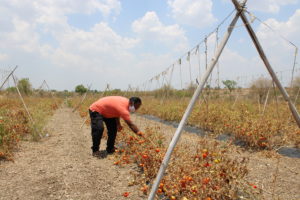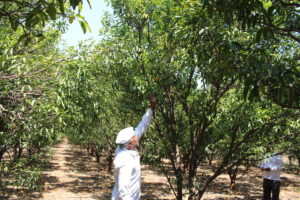Indian farmers to be doubly hit by Covid19

Ganesh Pandurang Pimple was forced to give away his tomato crop to the villagers as he could not find buyers (MIG Photos/Varsha Singh)
Agriculture is the principal source of revenue for nearly 65 pc of the Indian population. High time that the government looked at the severe impact that lockdown has had on farmers.
Low, undulating hills with various shades of green of the trees merging with the ochre of the land and blue of the sky in the distant horizon. At the first glance, the landscape could very well be in the famed Tuscany in Italy. But take another look. The temperature in shade at noon in late April is a scorcher at 37 degrees Celsius and the land is bone dry and barren in large patches.
It is in this setting that Ganesh Pandurang Pimple has a small land holding of barely 10 acres where he grows a mixed crop of brinjals, tomatoes and custard apple. The land is entirely rain fed but rains are rare in Ahmednagar which lies in the leeward side of the Western Ghats. Yet, with drip irrigation and water harvesting, Pimple and his brother manage a decent crop each year.
This year, too, the crop looked promising as brinjals and tomatoes grew aplenty. But then came the lockdown and the Pimple brothers were looking at the prospects of watching the crop rot on the plants in the absence of any farmhands to pluck the vegetables. “Faced with the prospect of seeing the crop destroyed, we decided that it was better that it came of some use to the villagers even if we had to give it away. So, we informed everyone in the neighbouring villages through our WhatsApp groups that they could come and take any quantity of the vegetables as per their needs from our farm,” Ganesh Pimple tells Media India Group.
Soon enough the farm was crowded with people, armed with sacks of all sizes to take away the crop. Alarmed that the people were ignoring social distancing norms, the Pimple brothers then modified the access and told the people that they could come to the farms in limited numbers at a time and only in regulated time slots throughout the day.
Two weeks on, as your correspondent visits the farm, there are still quite a few tomatoes, in various shades from light yellow to deep red clinging to the plants and in a nearby plot, a few unripe green brinjals are still growing. For the Pimple brothers, the loss from the farm comes at a particularly bad time as even their other source of income has been hit due to the coronavirus pandemic. Ganesh Pimple is a school teacher in the village primary school and his salary has been cut by 25 pc from the month of March as the government tries to raise funds to fight the pandemic.
Barely five km from the Pimple brothers’ village lies Khandala village where Govind Damle is yet another small farmer, with two small plots of land, each about an acre. Damle had grown coriander and had managed a decent harvest in early April. However, he says he was unable to sell it due to the lockdown. “Twice, I tried to go to the village market in order to sell the crop. However, on both the occasions, the policemen on duty beat me with sticks and asked me to go away. I was hurt and feeling too scared to go again to the market. So, I tried to sell the harvest in small bundles to the families in my village and the neighbourhood,” he says.
Damle’s story is anything but rare, not just in Ahmednagar, or even in Maharashtra, but indeed millions of farmers across the country have been faced with severe problems ever since the lockdown began on March 25. The problems are all very basic and they all stem from or have been exacerbated by the lockdown. The issues range from lack of farm hands to harvest the crop to the absence of transport facilities in order to cart the produce from the farm to the market and very often the markets remaining shut or without any buyers in view of the lockdown and absence of storage facilities even for crops that can stay longer, such as sugarcane or onions.
Onions make for an essential ingredient in Indian cuisine and last year due to a failed crop, onion prices had reached unprecedented high levels, retailing at INR 200 a kg for several weeks in urban areas as against a normal price range of INR 20-30 a kg. This attracted Sandesh Karle to plant onions in order to benefit from the high prices. Three months on, Karle rues his decision. The lockdown has effectively put paid to his plans. With the agricultural produce markets shut following the lockdown, there are hardly any wholesale buyers for onions. And making the situation even more challenging for Karle, there is a severe shortage of workers who could help him harvest the crop, leaving him no choice but to manage to harvest whatever he could on his own. On the day that your correspondent visited his house, Karle had heaps of freshly harvested onions piled in his garage. “Look at these onions. They need to be spread out properly in order that they dry. Then they need to be cropped, cleaned and filled in sacks for storage within a couple of days, before even this little bit of harvest goes waste,” he says.
He adds that he rues his decision to have planted onions as the market has completely collapsed. When I had planted the crop, the prices were over INR 100 a kilo, today I would be lucky if I could sell these off for anything more than INR 5 a kilo. My input cost itself has been INR 10 a kilo, so what is the point of even harvesting the crop as I will end up losing even more, unless I can store them properly and hope that the prices would rise back at least to their normal levels, if not the skyhigh mark at which they had reached last year,” he adds.
The absence of buyers, uncertain and opaque prices and blockades in transport are the biggest challenges facing farmers all around. Mohan Narayan Subekar and his brothers are relatively large farmers, holding over 50 acres between them. On a 5 acre plot, Subekar has an orange orchard which had an extremely good harvest this year, yet Subekar is anything but happy.

Narayan Subekar got less than what he expected for his oranges even though the harvest was more than last year’s
“I got almost half as many more oranges this year than the last year, but I made much more money last year,” he rues, adding that with the sword of lockdown and coronavirus pandemic hanging over him, he felt obliged to sell the produce to the first buyer who contacted him and he could not even negotiate the price properly as it clearly seemed to be a buyers’ market and that too with the uncertainty over its longevity as the markets have been opened and shut randomly across the country, without any logic or any method in the madness.
Subekar realises that he is better off than many other farmers include Pimple and Karle who have no fruits to show for their toil in the fields. Indeed, in the lockdown, both the producers and the consumers seem to be the losers, while the middlemen and traders seem to have made off with a handsome profit, with the prices having doubled and unusually high price volatility.
The farmers are worried not just about how much they could get for the crops that they have recently harvested, they are also equally worried, if not more, about their future in the next few months as the next sowing season is around the corner. “If I don’t have money to buy seeds, then what can I grow for the season and how,” says coriander farmer Damle. A large majority of Indian farmers barely make enough money to survive from a harvest to sowing fresh crops. A harvest gone wrong or the farmer unable to sell his crops at right price makes all the difference between the farming to continue or the farmer looking for a job either as a farmworker or migration to the city in hunt of better prospects.
The farmers, at least in Maharashtra, would have been in a far worse situation had it not been for the state government waiving their loans of upto INR 200,000 (USD 2700) a few months ago. “With the farm loan waived, most of the farmers, at least the small ones, have gotten rid of their biggest worry of an unpaid debt,” says Karle. He, however, says that the government ought to create a vibrant online farm market to allow the producers meet buyers in the digital space and for the price discovery of crops on a daily basis to be as dynamic and transparent as it is in any stock exchange. Though there is a rudimentary electronic farm market mounted by the federal government, clearly its signals have not been able to cross over the low hills of Ahmednagar and penetrate the heart of rural Maharashtra that lies beyond.
Though the Indian economy registered a strong growth for nearly 15 years before going into a slump three years ago, the farmers of India, notably small and marginal land holders that constitute an overwhelming majority, have not been able to reap the benefits of the economic boom and as a result the gap between rural and urban India has increased dramatically. Though the lockdown will hit the urban economy as well, the fragile state of farmers could see rural India fall even further behind whenever the economic growth returns.










